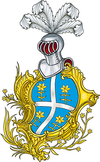Portobuffolé
| Portobuffolé | ||
|---|---|---|

|
|
|
| Country | Italy | |
| region | Veneto | |
| province | Treviso (TV) | |
| Local name | Portobuffolè | |
| Coordinates | 45 ° 51 ' N , 12 ° 32' E | |
| height | 10 m slm | |
| surface | 5.00 km² | |
| Residents | 750 (Dec. 31, 2019) | |
| Population density | 150 inhabitants / km² | |
| Post Code | 31040 | |
| prefix | 0422 | |
| ISTAT number | 026060 | |
| Popular name | Portobuffolesi, Portuensi | |
| Patron saint | Markus | |
| Website | www.comune.portobuffole.tv.it | |
Portobuffolé or Portobuffolè is a north-east Italian municipality ( comune ) with 750 inhabitants (as of December 31, 2019) in the province of Treviso in Veneto . The community is located about 31.5 kilometers northeast of Treviso on the Livenza and borders directly on the Friuli-Venezia Giulia region .
Portobuffolé is a member of the I borghi più belli d'Italia association (“The most beautiful places in Italy”).
history
The time when Portobuffolé was founded and the name derived from it are uncertain. Today's Portobuffolé is located in an area that was settled in Roman times and was known under the toponym Septimum de Liquentia until the 8th century. The name of the place is derived from its location, as it was seven miles from the ancient Opitergium, today's Oderzo , on the Livenza, the river already handed down by Pliny under the name Liquentia - a derivation that is also used for other Frazioni in Italy is to be proven.
In 997, the Bishop of Ceneda , Sicard, and the Doge of the Republic of Venice , Pietro II Orseolo , signed a lease for the castle and port, which were located in Septimum (castro et portu ... in loco Septimo) . This information has been related to the Castellarium Portus Buvoledi from a document from 1242 that first mentions the name Portobuffolés since the early 19th century . According to Angelo Marchesan, the name Buvoledi is derived from the Middle Latin word bova "channel".
If castrum et portus in loco Septimo and Portobuffolé are identical, the place initially belonged to the Patriarchate of Aquileia before it was given to the Bishop of Ceneda, Ripalto, in 908 by Berengar I as part of a courtship. Until 1166, when Portobuffolé came to Treviso , the feudal lords changed several times. Portobuffolé fell back to Ceneda as early as 1242. In order to damage the diocese, Gerardo Castelli destroyed the fortifications in 1282, which were restored by the bishops of Cenedas. In 1307 Tolberto III became. da Camino (1263–1317), husband of the poet Gaia da Camino (1270–1311), immortalized by Dante Alighieri in the Purgatorio , lord of Portobuffolé. After his death, his second wife Samaritana da Rimini asked the Doge of Venice for protection, but was only able to return to Portobuffolé in 1336.
By decision of Venice and Treviso, the place fell to the Republic of Venice in 1339 and now received the institutions of a Venetian city: Consiglio Civico and Consiglio Popolare , and a layer of nobili was installed. After the Chioggia war between the Republic of Venice and the Republic of Genoa between 1378 and 1381, a period of prosperity began for Portobuffolé . The place got city rights , coats of arms and a podium . The city developed into a small economic and cultural center and was the central court.
When Portobuffolé came under French rule in 1797 , it initially not only retained its jurisdiction for civil and criminal trials of the first instance, but also its area of responsibility was significantly expanded. But in the same year, as a result of the Peace of Campo Formio , the city fell to the Archduchy of Austria . The jurisdiction was withdrawn, which represented a turning point for the further development of the city. Although it became French again in 1806, after the Congress of Vienna in 1816 it became part of the Kingdom of Lombardy-Veneto and thus of the Austrian Empire . Like all communities in the Frazione di Settimo , Portobuffolé was incorporated into Brugnera by 1826 . The onset of population decline could no longer be compensated significantly, the population is now around the level of 1870. In 1965 and 1966, Portobuffolé was hit by two severe and destructive floods.
Duomo of Saints Mark and Prosdocimus
Web links
Individual evidence
- ↑ Statistiche demografiche ISTAT. Monthly population statistics of the Istituto Nazionale di Statistica , as of December 31 of 2019.
- ↑ The official website of the municipality and ISTAT use the spelling Portobuffolè, while the Dizionario d'ortografia e di pronunzia and the online lexicon Sapere.it , for example, run the municipality under the lemma Portobuffolé , and the municipality itself uses this form in some official documents and various pages of the website, for example here ; the Enciclopedie on line by Treccani dispenses with an accent; The spelling with an apostrophe is also often found, for example in the Bollettino Ufficiale della Regione del Veneto .
- ^ I borghi più belli d'Italia. Borghipiubelliditalia.it, accessed August 4, 2017 (Italian).
- ↑ Pliny, Naturalis historia 3.18.
- ↑ Jacopo Filiasi : Memorie storiche de 'Veneti. Volume 1. Padua 1811, p. 395 f.
- ↑ Angelo Marchesan: Gaia da Camino nei documenti trevisani. Turazza, Treviso 1904, p. 59.
- ^ Dante, Divina Commedia: Purgatorio 16. Gesang , verses 139-141.
- ^ History of the community on their website (Italian); Statuto del Comune di Portobuffole ' pp. 2-4 (PDF, Italian).




